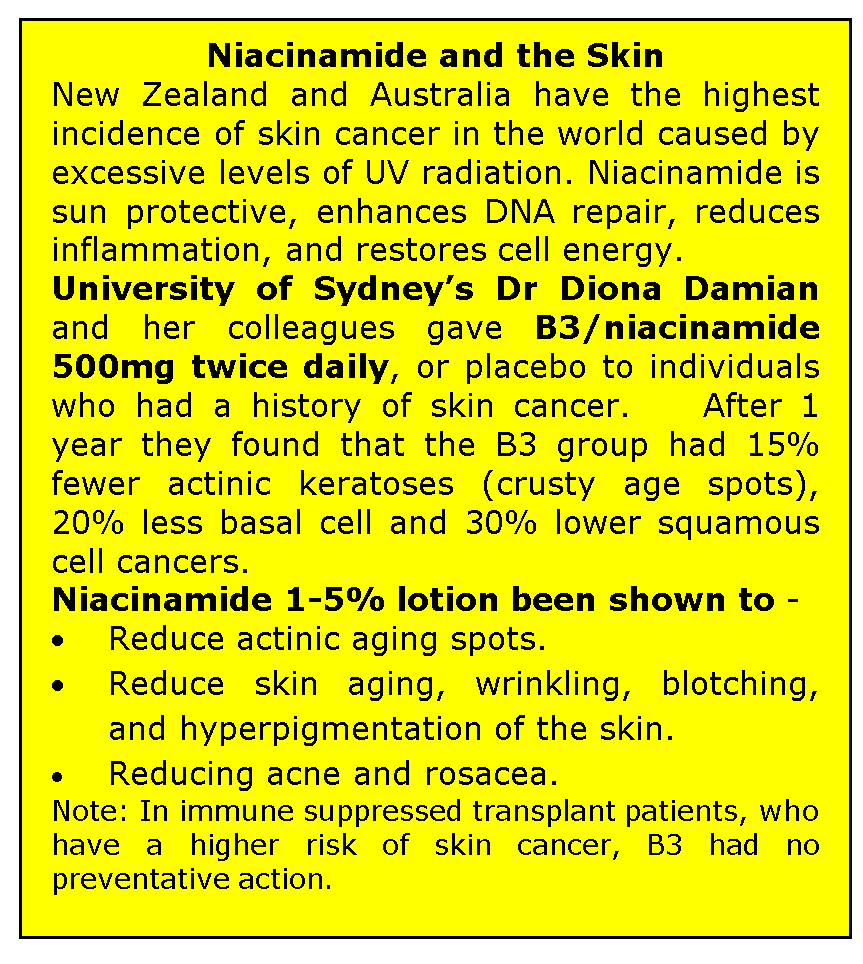Vitamin B3
Fact Sheet 29 - excerpt from December 2023 Newsletter
MITOCHONDRIA, EXERCISE & VITAMIN B3
In 2023 newsletters I have presented the importance of mitochondria, former bacteria that eons ago emerged with larger nucleus/DNA cells, to convert food and oxygen into energy to power more than 90% of the reactions in a cell. When we are young, mitochondria are abundant and efficient but after 40 the system loses efficiency, leading to chronic disease, ageing, and cancer. The good news is that mitochondria can be rejuvenated by the magic of intense mild to moderate exercise and autophagy, the complex cell-cleansing process that removes defective/dead mitochondria (mitophagy) and recycles cell components; autophagy is triggered by fasting, restricting calories and exercise.

PELLAGRA and WILLIAM KAUFMAN
In 1735, the Catalan physician Gaspal Casal described a skin affliction that affected the exposed areas of the hands, neck and feet; this became known as Asturian Leprosy. The same illness also created havoc in northern Italy, where Dr Francesco Frapolli of Milan named it pellagra, ‘pelle’ meaning skin and ‘agra’ sour. Pellagra is known for its 4D’s – (sun-exposed) Dermatitis, Diarrhoea, Dementia and Death. 200 years later, Professor Conrad Elvehjem showed this condition could be cured by taking vitamin B3.
Vitamin B3 is a group of foundation molecules (niacin, nicotinamide or niacinamide & more recently recognized nicotinamide mononucleotide and nicotinamide riboside) that are essential in the formation of Nicotinamide Adenine Dinucleotide (NAD). NAD plays a pivotal role in fueling the mitochondria electron-chain energy supply but is also an essential enzyme in DNA repair, cell communication, immune function and the synthesis or breakdown of nearly every molecule in the body. When B3 becomes deficient it affects the whole body and in particular, organs with high energy demand (Brain) and a rapid cell turnover (Gut & Skin). In the sidebar, I highlight niacinamide usefulness in treating skin conditions.
Dr William Kaufman was a pioneering orthomolecular physician, skilled in correcting deficiencies and imbalances based on an individual’s unique biochemistry. He meticulously recorded observations of patients using high dose niacinamide and other vitamins, and documented his findings. Kaufman used large doses of niacinamide to treat osteoarthritis. In one interview he said “One of my first patients was so severely arthritic … he could not bend his elbows enough to measure his blood pressure. I gave him niacinamide for a week in divided doses, and then he could bend his arm. I took him off it and gave him a look-alike medicine (placebo). In a week he was back where he was before; his joints were stiff again.” Kaufman’s observations were validated in a small pilot trial in 1996 which found that ‘niacinamide improved the global impact of osteoarthritis, improved joint flexibility, reduced inflammation, and allowed for reduction in standard anti-inflammatory medications.’
Kaufman also observed that niacinamide had a calming effect, patients became less driven, had increased energy and improved wellbeing so he used it for patients who were stressed, anxious and suffering ADHD. In 1979 drug company Hoffman La-Roche published data confirming that niacinamide did indeed have a benzodiazepine/valium-like effect on the brain.
